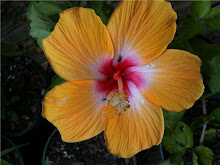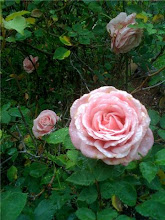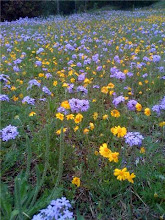
 There are many floral hydrosols that I enjoy incorporating into my skin care blends. Some of my favorites are rose, orange blossom, lavender, calendula, lemon balm, and chamomile. I love orange blossom hydrosol. It makes my Calendula Orange Blossom: The Daily Lotion smell so sweet. You can make just about any hydrosol you desire....all one needs is a steam distiller.
There are many floral hydrosols that I enjoy incorporating into my skin care blends. Some of my favorites are rose, orange blossom, lavender, calendula, lemon balm, and chamomile. I love orange blossom hydrosol. It makes my Calendula Orange Blossom: The Daily Lotion smell so sweet. You can make just about any hydrosol you desire....all one needs is a steam distiller.Here's a beautiful copper steam distiller made by Al-Ambiq. These pictures were taken last fall at Rootstalk Festival, an herb conference celebrating plants, people and planet benefiting Cascadia Wildlands. The good folks at Mountain Rose really did a fine job putting on this conference. It was my favorite thus far. It was held in Oregon and I can't say enough about it. Sadly, this was the first and last Rootstalk Festival they will put on.
This is Ann Harman's copper distiller (from Morning Myst Botanicals). She presented a live demonstration on how to assemble the distiller and make essential oil and hydrosol using lemon thyme plant matter.
Hydrosols, or essential waters, are a co-product of essential oil making. Hydrosols and essential oils are created when you steam distill plant matter. In this case, after assembly, Ann added water and plant matter into the distiller. As the distiller produces heat, the plants release their essential oils and are carried through the distiller's coils.
It vaporizes the water and the essential oils from the plants. The condensing coil, shown here in this picture, is a coil submerged in cool water. When the steam travels through the condensing coil, the steam and essential oil condenses from a vapor into a liquid. The liquid (hydrosol and oil) drips into the glass receiving element shown below.
 Here, you can see the results of the steam distillation process: the darker golden line above the water is the essential oil and since oil and water don't mix...the oil will float above the water. The water portion below the essential oil is the beautiful hydrosol. Hydrosols also possess the fragrance of the plant. Although the fragrance is not as strong as the essential oil, it is still a delicate representation of the essence of the plant.
Here, you can see the results of the steam distillation process: the darker golden line above the water is the essential oil and since oil and water don't mix...the oil will float above the water. The water portion below the essential oil is the beautiful hydrosol. Hydrosols also possess the fragrance of the plant. Although the fragrance is not as strong as the essential oil, it is still a delicate representation of the essence of the plant.
Hydrosols are not only deliciously fragrant, they carry many of the benefits of the plant. They carry beneficial plant acids and are anti-inflammatory. Hydrosols help heal, tone, restore pH balance and hydrate skin. Hydrosols are also wonderful because of their antioxidant properties. Plant acids can have wonderful impacts on the skin. Rose hydrosol, for example, has a long history for being known to help hydrate skin and reduce fine lines on the face.
Due to its mild and therapeutic benefits, I use calendula hydrosol topically to help heal irritations on my cat, Basil. Like many cats, Basil does not like to tolerate much in terms of therapeutic intervention, but he enjoys the calendula hydrosol when applied to his skin. He is very allergic to fleas and if he gets bitten he will quickly get inflamed lips and sores. After applying the hydrosol with a cotton ball on his skin, his inflammation is reduced and his sores heal faster.
I encourage you to keep researching and reading about the many benefits of hydrosols in skin care. For facial mists, I love to keep it simple: rose and lavender hydrosol. Rose hydrosol is a wrinkle fighting beauty secret and lavender is so loving to the skin making it wonderful for even those with the most delicate and sensitive skin.
When purchasing hydrosol for skin care, be sure to purchase from a distiller whose main objective is to make hydrosol rather than essential oil. If it's a hydrosol that is a byproduct of essential oil, then the flowers and plant matter used may not be as fresh and full of the wonderful watery elements you want when enjoying hydrosol. However, if the distiller's main objective is making hydrosol, then you will ultimately have the best representation of hydrosol.
















+and+wildflowers+loving+the+field.jpg)








1 comment:
I Like this.
Thanks
Hakan
Post a Comment